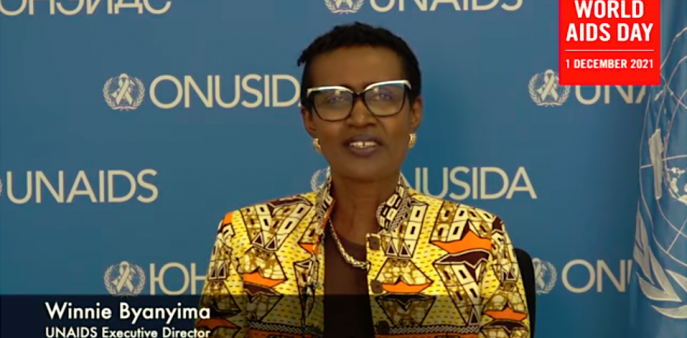In the next 10 years, 7.7 million people could die of AIDS-related causes unless leaders address inequalities, warns the Joint United Nations Programme on HIV/AIDS (UNAIDS) in a report released for World AIDS Day, December 1.
“This is an urgent call to action,” said UNAIDS executive director Winnie Byanyima, in a press release about the report. “Progress against the AIDS pandemic, which was already offtrack, is now under even greater strain as the COVID-19 crisis continues to rage, disrupting HIV prevention and treatment services, schooling, violence-prevention programs and more. We cannot be forced to choose between ending the AIDS pandemic today and preparing for the pandemics of tomorrow. The only successful approach will achieve both. As of now, we are not on track to achieve either.”
The 73-page report, which you can read and download online, is titled Unequal, Unprepared, Under Threat: Why bold action against inequalities is needed to end AIDS, stop COVID-19 and prepare for future pandemics.

The cover of the 2021 World AIDS Day report by UNAIDSUNAIDS.org
Amid the dire warnings, however, is a possible path to avert or at least minimize the millions of AIDS-related deaths. If nations invest in laws and policies that address the inequalities driving HIV rates, they might manage to end the AIDS epidemic by 2030. In fact, a plan to accomplish this goal was laid out this summer during a U.N. High-Level Meeting on AIDS (the United Nations’ last meeting on the topic was in 2016).
The plan includes five elements central to ending AIDS. The World AIDS Day report devotes a chapter to each one. They are:
- Community-led and community-based infrastructure;
- Equitable access to medicines, vaccines and health technologies;
- Supporting workers on the pandemic front lines;
- Human rights at the center of pandemic responses;
- People-centered data systems that highlight inequalities.
“The report highlights two important reasons for hope,” writes Helen Clark, a former prime minister of New Zealand and cochair of the Independent Panel for Pandemic Preparedness and Response, in the foreword to the UNAIDS report. “First, we have strong evidence of approaches that work. We now need to apply those lessons at scale, everywhere. Second, we have a global plan, agreed at the United Nations General Assembly’s High-Level Meeting on Ending AIDS earlier this year. If put into practice, the measures agreed by the General Assembly will enable the world to end the inequalities which drive HIV and AIDS and pave the way to pandemic preparedness.”
“This year, the world agreed on a bold plan that, if leaders fulfill it, will end AIDS by 2030. That’s so exciting,” said Byanyima in a related video statement posted for World AIDS Day. (You can watch the video at the top of this article or read a transcript on UNAIDS.org.) “But today we, as the Joint United Nations Programme on HIV/AIDS, issue a stark warning. AIDS remains a pandemic, the red light is flashing, and only by moving fast to end the inequalities that drive the pandemic can we overcome it.…
“Pathogens ranging from HIV to the virus behind COVID-19 invade the cracks and fissures in our society with startling opportunism,” added Paul Farmer of the nonprofit Partners in Health. “That the AIDS pandemic is shaped by deep structural inequalities need not resign us to inaction, however. Our teams, in rural Haiti and across the world, have routinely shown that with comprehensive care delivery, robust forms of accompaniment and social support and a larger dose of social justice, disparities in HIV outcomes can be rapidly narrowed and health systems swiftly strengthened. We shouldn’t settle for anything less.”
Countries that address inequalities and support strong community engagement and inclusive health care systems have seen the best results in their battles against HIV, according to the UNAIDS report. But certain populations remain more vulnerable, and the COVID-19 pandemic has resulted in setbacks and additional challenges. As the press release summarizes:
Some countries, including some with the highest rates of HIV, have made remarkable progress against AIDS, illustrating what is feasible. However, new HIV infections are not falling fast enough globally to stop the pandemic, with 1.5 million new HIV infections in 2020 and growing HIV infection rates in some countries. Infections are also following lines of inequality. Six in seven new HIV infections among adolescents in sub-Saharan Africa are occurring among adolescent girls. Gay men and other men who have sex with men, sex workers and people who use drugs face a 25–35 times greater risk of acquiring HIV worldwide.
COVID-19 is undercutting the AIDS response in many places. The pace of HIV testing declined almost uniformly and fewer people living with HIV initiated treatment in 2020 in 40 of 50 countries reporting to UNAIDS. HIV prevention services have been impacted—in 2020, harm reduction services for people who use drugs were disrupted in 65% of 130 countries surveyed.
“There is not a choice to be made between ending the AIDS pandemic that is raging today and preparing for the pandemics of tomorrow,” stressed Byanyima in her video statement. “If we take on the inequalities that hold back progress, we can deliver on the promise to end AIDS by 2030. It is in our hands.… End inequalities. End AIDS. End pandemics.”
Click here to read the full UNAIDS report.







Comments
Comments